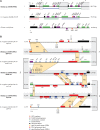Mitochondrial genome rearrangements in glomus species triggered by homologous recombination between distinct mtDNA haplotypes
- PMID: 23925788
- PMCID: PMC3787672
- DOI: 10.1093/gbe/evt120
Mitochondrial genome rearrangements in glomus species triggered by homologous recombination between distinct mtDNA haplotypes
Abstract
Comparative mitochondrial genomics of arbuscular mycorrhizal fungi (AMF) provide new avenues to overcome long-lasting obstacles that have hampered studies aimed at understanding the community structure, diversity, and evolution of these multinucleated and genetically polymorphic organisms.AMF mitochondrial (mt) genomes are homogeneous within isolates, and their intergenic regions harbor numerous mobile elements that have rapidly diverged, including homing endonuclease genes, small inverted repeats, and plasmid-related DNA polymerase genes (dpo), making them suitable targets for the development of reliable strain-specific markers. However, these elements may also lead to genome rearrangements through homologous recombination, although this has never previously been reported in this group of obligate symbiotic fungi. To investigate whether such rearrangements are present and caused by mobile elements in AMF, the mitochondrial genomes from two Glomeraceae members (i.e., Glomus cerebriforme and Glomus sp.) with substantial mtDNA synteny divergence,were sequenced and compared with available glomeromycotan mitochondrial genomes. We used an extensive nucleotide/protein similarity network-based approach to investigated podiversity in AMF as well as in other organisms for which sequences are publicly available. We provide strong evidence of dpo-induced inter-haplotype recombination, leading to a reshuffled mitochondrial genome in Glomus sp. These findings raise questions as to whether AMF single spore cultivations artificially underestimate mtDNA genetic diversity.We assessed potential dpo dispersal mechanisms in AMF and inferred a robust phylogenetic relationship with plant mitochondrial plasmids. Along with other indirect evidence, our analyses indicate that members of the Glomeromycota phylum are potential donors of mitochondrial plasmids to plants.
Figures




References
-
- Akins RA, et al. Nucleotide sequence of the Varkud mitochondrial plasmid of Neurospora and synthesis of a hybrid transcript with a 5′ leader derived from mitochondrial RNA. J Mol Biol. 1988;204:1–25. - PubMed
-
- Akins RA, Kelley RL, Lambowitz AM. Mitochondrial plasmids of Neurospora: integration into mitochondrial DNA and evidence for reverse transcription in mitochondria. Cell. 1986;47:505–516. - PubMed
-
- Altschul SF, Gish W, Miller W, Myers EW, Lipman DJ. Basic local alignment search tool. J Mol Biol. 1990;215:403–410. - PubMed
-
- André C, Levy A, Walbot V. Small repeated sequences and the structure of plant mitochondrial genomes. Trends Genet. 1992;8:128–132. - PubMed
Publication types
MeSH terms
Substances
LinkOut - more resources
Full Text Sources
Other Literature Sources

